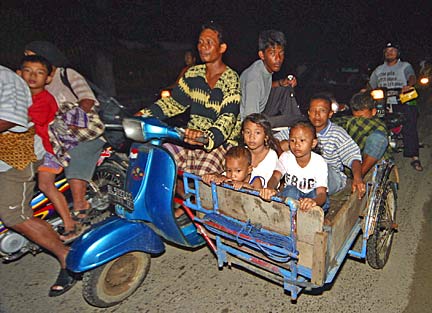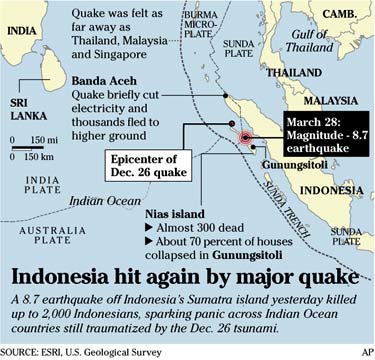
A worker at the meteorology and geophysics office in Jakarta, Indonesia, pointed yesterday to a seismograph of the 8.7 earthquake that rocked Sumatra.
Many flee a tsunami
that never comes
Lack of massive waves puzzles
scientists at warning center
Tsunami experts were "baffled" that yesterday's forceful earthquake off Indonesia failed to launch massive waves similar to those generated by the quake three months ago that killed at least 175,000 people in the same region.
A magnitude-8.7 quake shook Indonesia's west coast, killing hundreds of people and spreading panic across the Indian Ocean that another killer tsunami was on the way.
There was no destructive tsunami generated, but a small wave was detected by a tide gauge on Cocos Island near Australia, about 1,500 miles south of the epicenter, according to the Pacific Tsunami Warning Center on Oahu.
"I'm baffled an earthquake this size didn't trigger a tsunami near the epicenter," said Robert Cessaro, a geophysicist at the center, which is operated by the National Oceanic and Atmospheric Administration, or NOAA.
Charles McCreery, director of the center charged with monitoring seismic and ocean conditions in the Pacific and alerting Pacific Rim nations and U.S. agencies, said earthquakes of at least 8.0 magnitude usually generate major tsunamis.
"We expected some destructive tsunami with some distant destructive affects. It was surprising," he said.
The latest event also demonstrated "there's a whole world of uncertainty about trying to judge a tsunami based on the earthquake data," he said.

David Burwell, an oceanographer at the Pacific Tsunami Warning Center, pointed yesterday to the location of a small tsunami that hit Hanimaadhoo in the Maldives Islands, southwest of India, as a result of an earthquake off Sumatra.
Yesterday's preliminary estimate was higher, magnitude 8.5, but had no destructive tsunami.
"The one we initially thought was bigger turns out to have no effect," McCreery said. "The one we initially thought was smaller had a huge effect. This is the challenge of tsunami warning."
Some scientists believe the depth of the quake was the reason no tsunami was generated.
The U.S. Geological Survey said yesterday's quake struck about 19 miles under the seabed. The Dec. 26 quake was closer to the surface.
"What causes a tsunami is if the ocean floor heaves, so if it's a very shallow tsunami, it's apt to heave the floor more than a deeper one. If it's very deep, it sort of gets absorbed on its way up," said Allen Clark, director of the Pacific Disaster Center on Maui.

In this TV image, residents were seen flocking into the streets in the town of Hadyai, Thailand, late yesterday after an earthquake was felt throughout the region.
Earlier this month, a group of 58 European tsunami survivors and relatives of victims sued NOAA and other agencies, alleging the center did not do enough to warn people about the disaster.
NOAA officials noted the center has "no official responsibility" for the Indian Ocean and that they previously had no communications set up with countries in that area.
"Although we certainly wish that somehow the event unfolded in a way that we could've done more for the region, we really did all we could under the circumstances," McCreery said. "I'm confident there won't be much to come from this lawsuit."
Since then, several Indian Ocean nations have established communications with the center and are now on its alert list.
Yesterday, the facility was able to alert those nations with its bulletins electronically, by e-mail, fax, and some were also called as a backup.

People in Banda Aceh, Indonesia, crammed onto a scooter and cart today as they drove to higher ground following the major earthquake that struck late yesterday off the west coast of Indonesia's Sumatra island.
The Indian Ocean currently has no warning center similar to the one in Hawaii.
"But we have agreed to provide this information in an effort to save lives," McCreery said. "We issued the information about the strong possibility of tsunamis in the region. We have understood from the phone calls we've been making today that they did receive the bulletin and were able to act on them."
Scientists said the biggest difference for the quick response this time around is that there is heightened awareness of tsunamis.
"In the case of the Indian Ocean, we could yell 'tsunami,' but until that event happened, nobody would know what to do," Cessaro said.

[News] [Business] [Features] [Sports] [Editorial] [Do It Electric!]
[Classified Ads] [Search] [Subscribe] [Info] [Letter to Editor]
[Feedback]
